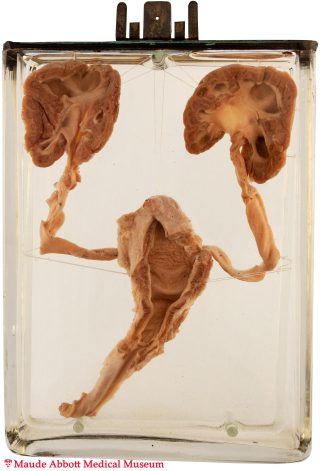

Enlarge
Donor: Royal Victoria Hospital
Date: 1960
Size (H x W x D cm): 19 x 14 x 7
The urethra shows a thin horizontal valve in its posterior aspect (A, arrow). The ureters are mildly and renal pelvices moderately dilated. The urinary bladder shows both dilatation and muscle hypertrophy (manifested as a thickened wall).
A. Click on image to enlarge.
History: Male infant born 2 weeks before term. Postnatally, there was dribbling urination without obvious bladder distension. Six days after birth, the infant became hypotensive, with an elevated white cell count and hyperkalemia. Death followed soon after. At autopsy, the anterior part of the corpus callosum was absent on the left side of the brain; no information is available concerning possible pulmonary hypoplasia.
Comment: During the 4th to 7th weeks of development, the cloaca divides into posterior (anorectal canal) and anterior (urogenital sinus) compartments. The two are delimited from the amniotic cavity by the anorectal and urogenital membranes, respectively. The male urethra originates in the urogenital sinus, which develops into the bladder proximally, the membranous and prostatic urethra in its middle (pelvic) portion, and the phallic urethra distally.
The abnormality responsible for the urethral obstruction is uncertain. However, most valves are thought to extend from the bottom of the verumontanum (the urethral enlargement at the origin of the ejaculatory ducts) distally along the prostatic urethra. There is evidence that they represent persistence of the urogenital membrane.
A posterior urethral valve (urethral membrane) is the most common cause of bladder outlet obstruction in male infants (about 1 in 5000 to 8000 live births). The disorder varies in severity from mild to severe, the latter often complicated by respiratory failure secondary to pulmonary hypoplasia as result of decreased amniotic fluid (oligohydramnios). In addition to hydronephrosis, some kidneys have cortical cysts (varying from one or two to innumerable (multicystic dysplasia; see specimen 33)).
